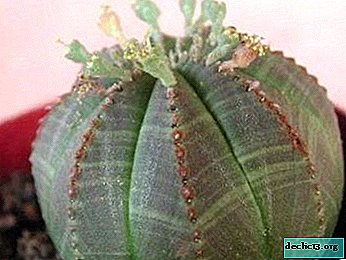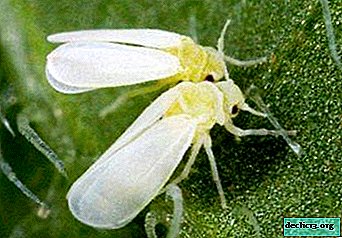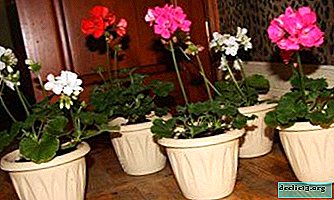Miracle Balls Euphorbia fat! Plant Care and Reproduction

Recently, Euphorbia is gaining more and more popularity among gardeners. And this is not surprising, since the outlandish plant captivates with its beauty and surprises with a wide variety of species. Representatives of the family are so different among themselves that it is difficult to believe that they belong to the same species.
In this article we will talk about Euphorbia fat, how it differs from other species. What are the rules for caring for him, how to breed. And also what difficulties a flower grower may have when growing him at home: what diseases and pests should be feared.
Botanical Description
Fat Euphorbia - a kind of Euphorbia obesa (Euphorbia obesa), a small succulent plant that looks like a cactus. Its shape is spherical, in appearance resembles a stone or a brown-green ball. This plant has no thorns and leaves, but sometimes it forms “branches” that look like a set of small spheres. It grows in height from 15 to 30 centimeters, and in diameter up to 10 centimeters. The end of the root is conical. The trunk is often octagonal, without branches, domed or spherical. Over time, it becomes cylindrical or conical in shape.
Euphorbia obese is green, gray-green, brown-green or steel in color, with brown-red or purple transverse stripes. The young plant has a rounded body and vertical, wide ribs. With age, the number of ribs increases. The foliage is small and quickly falls off.This flower is bisexual. Male flowers on one plant, and female flowers on another. Pedicels are branched, leaves are small. Cyatias are cup-shaped, 3 mm in diameter, with female flowers expanded. Inflorescences emit a delicate aroma. Cross-pollination, which is usually carried out by insects, is necessary for fruit setting.
Fat euphorbia is not always called that way, sometimes instead of the second word they write - bold, and sometimes - chubby. This contributes to its unusual spherical shape.
Photo
Check out the flower photo below.




Features and differences
- Unusual spherical shape of the plant.
- Lack of foliage.
- Euphorbia is a fat dioecious plant.
- Absolutely unpretentious flower in leaving.
- Flowering is rare.
- Photophilous and drought tolerant.
- It can withstand frost up to -10˚C degrees.
Care
- Temperature in the summer and spring for this species should be within +25 + 30˚C degrees. In autumn and winter, the plant requires a decrease in temperature, since a dormant period begins. Fat euphorbia withstands frosts down to -10˚C, so you can not really worry about the temperature regime in the cool season.
- Watering. Proper watering is very important for succulents.It is necessary that once a week the soil is almost completely dry. This is due to the fact that most of the species can accumulate water in the stems. That is why it is important not to fill the flower.
In autumn and spring, watering once every few weeks will be sufficient, and in winter even less once a month.
- Shine. Euphorbia is a photophilous plant that requires a large amount of sunlight. The ideal place for him would be the south or southeast side of the apartment. However, do not forget that the lighting should be diffused. A flower can bear constant direct rays only if it moistens the soil in time and gives it the optimal amount of fresh air.
 Pruning. Not all species need pruning. It is carried out only for those varieties of milkweed, which by nature have long stems, prone to branching. Milk to the fat pruning is not needed, since its stem is massive and has a spherical shape. This representative does not even have foliage.
Pruning. Not all species need pruning. It is carried out only for those varieties of milkweed, which by nature have long stems, prone to branching. Milk to the fat pruning is not needed, since its stem is massive and has a spherical shape. This representative does not even have foliage.- Top dressing. Milkweed need nutrition during the growing phase. During this period, it is recommended to perform them once every few weeks. Fertilizers for cacti or succulents are suitable. Fertilizers with a high nitrogen content should be avoided.
- Pot. It can be of any shape, but it is important to choose a container with certain parameters. It takes a shallow but wide pot. Capacity should not constrain the root system. Holes are required at the bottom of the pot for normal air circulation.
Breeding
Fat milkweed breeds only in one way - seed. To do this at home, you need to know the following:
- When seed boxes appear on the plant, you need to cover the female flower with a fine mesh. This is done so as not to lose seeds.
- Boxes mature within 10 days.
- Then they burst, throwing the seeds out.
- Then the seeds must be sown in moist soil mixed with sand.
- The pot in which the seeds were planted should be covered with a film.
- Now the pot is placed in a bright place.
- After germination, the film is removed.
- When they reach 1-2 centimeters, they need to be transplanted into a terracotta pot.
The main disadvantage of this method is that it is the only one. Also, in order to get seeds, with the help of which you can further grow the plant, you need a male and female copy.
This is a dioecious plant, which means that pollen from a male flower must be transferred to a female individual and only after that seed boxes will appear. From the foregoing, we can conclude that the process of growing this species is not so easy.Diseases and Pests
 Whitefly - one of the problems of this plant. It can easily be removed from the flower, but it is very important to check the root system. For large-scale damage, insecticides suitable for this type are used.
Whitefly - one of the problems of this plant. It can easily be removed from the flower, but it is very important to check the root system. For large-scale damage, insecticides suitable for this type are used.- If the milkweed surface has become sticky, and the stem is covered with yellow spots, then it settled mealybug. The pest can be removed with a cosmetic stick. With severe damage, an insecticide is also used.
- Fluffy whitish spots are a clear sign mold. It may appear from excessive moisture. With this disease fungicide copes well.
Conclusion
Fat euphorbia is a unique and inimitable plant. He is absolutely not picky about leaving. If you want to see at home some unusual, non-standard and at the same time beautiful flower, then this type is perfect.

 Pruning. Not all species need pruning. It is carried out only for those varieties of milkweed, which by nature have long stems, prone to branching. Milk to the fat pruning is not needed, since its stem is massive and has a spherical shape. This representative does not even have foliage.
Pruning. Not all species need pruning. It is carried out only for those varieties of milkweed, which by nature have long stems, prone to branching. Milk to the fat pruning is not needed, since its stem is massive and has a spherical shape. This representative does not even have foliage. Whitefly - one of the problems of this plant. It can easily be removed from the flower, but it is very important to check the root system. For large-scale damage, insecticides suitable for this type are used.
Whitefly - one of the problems of this plant. It can easily be removed from the flower, but it is very important to check the root system. For large-scale damage, insecticides suitable for this type are used.















